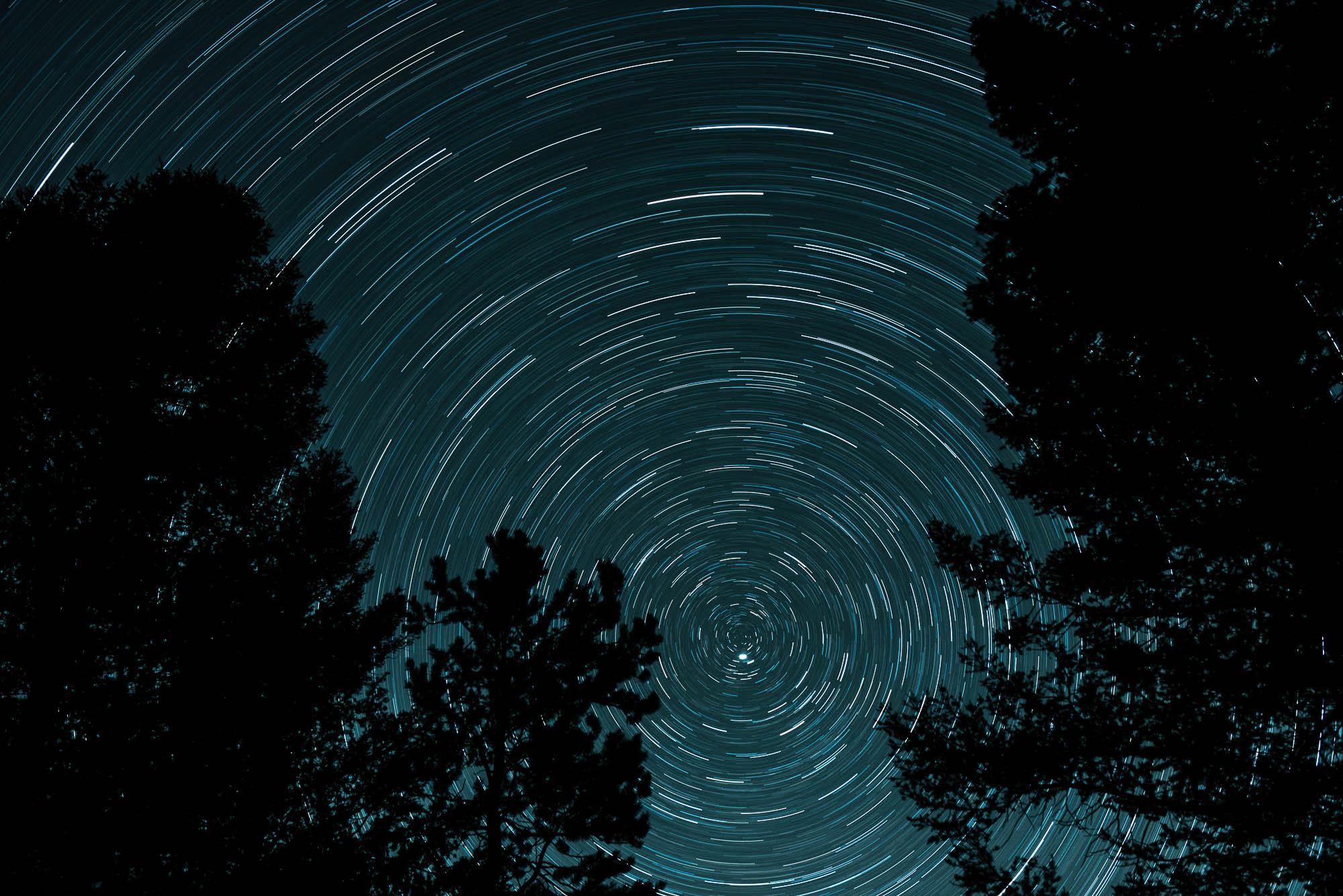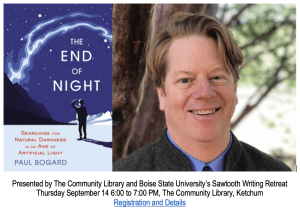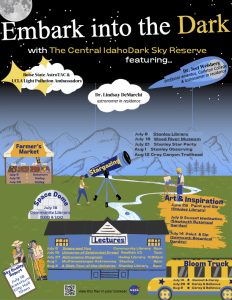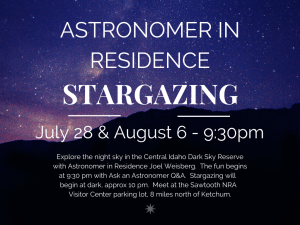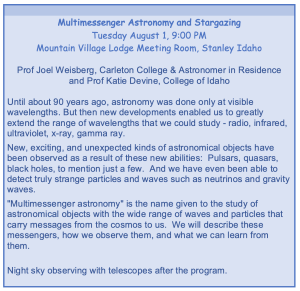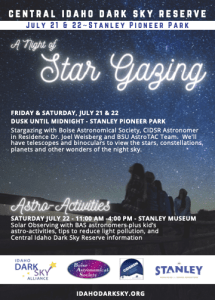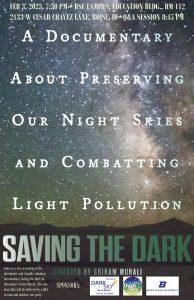2019
June 14 — Craters of the Moon (Arco), Full Moon Hike: Experience Craters of the Moon beneath the full moon! Bring a flashlight, hiking shoes, water, and your curiosity about our lunar connections.Reservations are required and walks will be limited to 25 people. Contact the park at 208-527-1335 or crmo_information@nps.gov to make a reservation.
June 21 — Ketchum Town Square (Ketchum), 6:00 pm – 9:00 pm, Summer Solstice Soiree: Join us for a Dark Sky Celebration!
June 28-29 — Craters of the Moon (Arco), 9:30 pm, Star Party: Join experts from the Idaho Falls Astronomical Society and our very own “Astro-Ranger” to experience the universe at this International Dark Sky Park. Opportunities for solar viewing will be available at the visitor center both days. At 9:30 p.m. each evening there will be a presentation about the night sky at the campground amphitheater. Then head to the Caves Area parking lot for telescope viewing of the skies above. Call 208-527-1335 for more information.
July 20 — Craters of the Moon (Arco), Craters of the Moon staff and partner organizations will host a special event celebrating the 50th anniversary of astronauts walking on the “Moon” (on the lunar surface and right here in Idaho!). Special activities will include presentations by astronaut John Phillips, youth activities, and opportunities to view the lunar surface through a telescope. MOONFEST events will take place from 9:30 a.m. to 5 p.m. at the Robert Limbert Visitor Center and from 8 p.m. to 10:30 p.m. at the Lava Flow Campground Amphitheater
August 23 —Stanley Museum (Stanley), 5 pm – 6 pm, Forum and LectureSeries: Astronomy Before Galileo with Brian Jackson
2018
May 22 — Sawtooth Botanical Garden, Astronomy in the Garden — Shoot the night sky with your camera or cell phone
www.sbgarden.org
June 15 – 16 — Stanley Pioneer Park, Dark Sky Celebration and Star Party, Stanley-Sawtooth Chamber of Commerce www.stanleycc.org
July 6 — Stanley Museum, 5 pm: The Scorpion, the Archer and the Swan: Stars of the Summer Milky Way with Tim Frazier, Sawtooth Interpretive & Historical Association (SIHA)
www.discoversawtooth.org
July 7, 8, 14, 15, 21, 22, 28 & 29 — Craters of the Moon: 9:30 pm – 11 pm: Astronomy Programs: Join us at the Visitor Center for a short presentation followed by viewing opportunities through the park’s telescope. Bring a chair or blanket to sit on, dress warmly, bring a flashlight to get back to camp but please use red lights only once in the viewing area. https://www.nps.gov/crmo/index.htm
July 19 – 20 — Arco & Craters of the Moon: American Solar Challenge – Come cheer on university teams as they drive their solar powered vehicles across the nation. These teams will stop in Arco on July 19 and then start from Craters of the Moon on July 20. The event in Arco will take place at Butte High School from 10 a.m. – 3 p.m. Besides viewing the cars, there will also be opportunities to learn more about scientific research with displays about space science, dark skies, and the Oregon Trail. On July 20, the cars will start from the Devil’s Orchard trailhead at Craters of the Moon beginning at 9:00 a.m. https://www.nps.gov/crmo/index.htm
July 27 — Stanley Museum, 5 pm: Dark Sky Photography with Nils Ribi, Sawtooth Interpretive & Historical Association www.discoversawtooth.org
July 27 — Craters of the Moon, 9 pm – 11 pm: Full Moon Hike: Explore this unearthly landscape under a full moon. Cooler temperatures make this moderate, 1-mile evening hike pleasant. Wear sturdy shoes, and bring snacks, water, and a light jacket. Reservations are required; please call 208-527-1335 or contact us by email:
crmo_information@nps.gov
July 28 — Stanley Library: Science of Planetary Exploration and the Search for Extraterrestrial Life, 6:00 PM- Join Dr. Brian Jackson, Professor of Physics/Astronomy, Boise State University for a one hour lecture followed by two hours of general stargazing with a telescope at the Stanley Ranger Station parking lot.
August 3 – 4— Craters of the Moon: Star Party – Join experts from the Idaho Falls Astronomical Society and experience the universe under our naturally dark skies. Telescopes will be set up in the Caves Area parking lot for viewing the stars and planets. Dress warmly and bring flashlights. Red lights preferred for optimal dark sky viewing. https://www.nps.gov/crmo/index.htm
August 4 – 5 — Coyote Yurt (Smoky Mountains near Ketchum) – Overnight Trek into the Central Idaho Dark Sky Reserve: Sun Valley Trekking and the Idaho Conservation League are teaming up to bring you the Milky Way. Join us to experience the night sky like nowhere else. You don’t want to miss one of the most unique backcountry mountain star gazing adventures on the planet! Call Sun Valley Trekking at 208.788.1966 to reserve your spot. www.idahoconservation.org
August 10 — Stanley City Park, Perseid Meteor Shower, stargazing, and discussion of Central Idaho Dark Sky Reserve, join Dr. Matt Benjamin, freelance astronomer, for a free evening of stargazing, 9:30PM – 11:00PM
August 12 — Sawtooth Botanical Garden, Astronomy in the Garden – Family night at Croy Canyon
www.sbgarden.org
August 31 — Stanley Museum, 5 pm, Songbirds and the Stars with Heidi Ware, Sawtooth Interpretive & Historical Association
www.discoversawtooth.org
